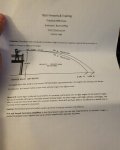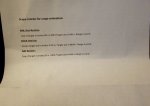SO, I attended a local ish basic precision rifle class with an outfit I have never heard of before. I know, I know, this can only end well. The day started with us meeting in the parking lot of the local community college in ammunition laden vehicles. I don't have an issue with this, but the state might. We drove to a farm property where the range was located. I can dig, its middle Georgia, that's not an unusual occurrence. The instructor introduced himself and told us about his experience as a Marine scout sniper. He then proceeded to start the "classroom" portion of the instruction. It lasted no more than 30 minutes and provided nothing of value (pictures will be provided of the handouts). So now that everyone knows what they are doing... Nothing was said about safety prior to flagging each other repeatedly. So lets zero, er confirm zero, no your not even on paper... The loner rifles were not zeroed, the "assistant" who was also attending the class, wasn't even on paper and I had to zero his rifle for him (fml). There goes half the day... We then proceeded to shoot at a KYL at 100, 200 and 300 from the prone, not the worst route but when did we discuss shooting positions, oh we didn't. Oh squirrel, lets do range estimations and mil some targets! "20 inch plate is x mills, use this formula and give me a range." Its a fucking 12 inch plate and this dude cant figure out why everyone's math is wrong... Sweet, we all got it wrong, now to speed shooting drills and tannerite... What in the actual fuck is going on? I sent him an email that is probably way nicer than it should have been.
"
Hey ****,
I want to preface by saying I do not doubt your abilities or knowledge, but I have some criticism of the precision rifle course you hosted. Please take this as me being constructive and not slanderous. I know I am far from a professional trigger man, but I see room for improvement. My thoughts will be listed in bullet points and blurbs; I’m no English major, so please keep that in mind while navigating my ramblings.
It is arbitrary and everyone is tired of hearing it, but safe handling of firearms should always be addressed, especially during a beginner’s course. At a minimum discuss the conditions in which a firearm will be set aside and pointed when not on a firing line.
When it comes to precision rifle, every point of pressure and how you contact the rifle influences your shot. Having an appropriately fit rifle is, in my opinion, more important than an accurate rifle. Fitting a rifle should be addressed before a single shot is fired. Length of pull, comb height, eye relief, scope height and bipod setup. These are things that should be done prior to arrival. Many courses, in the firearms industry and others, issue a prep booklet. Similar to a match booklet for 2-day matches, discussing what should be done prior to arrival and in preparation of the event. I think this could be a great resource and used to address many things.
Bringing a zeroed rifle is crucial. It was half our day. I understand confirming zero, I was 2/10ths high today, but if you aren’t on paper something is wrong. Period.
When talking positional shooting or just basic positions, discussing natural point of aim is crucial. Understanding how you address the rifle will affect how it points is an integral part of fundamentals.
While we are on the subject of fundamentals, if you start the class stating that fundamentals are the foundation of shooting, please correct issues with people’s fundamentals. I understand that your desire to have media of a newly introduced course, but leading people to believe they are succeeding where they are not will ultimately be a hindrance and not a help on their shooting journey.
Your explanation of external ballistics and drop was nonexistent. Understanding how a bullet’s trajectory can be calculated and determined based on easily extrapolated data is the foundation of shooting at range. Ballistic calculators are plentiful and free. 3 DOF point mass calculators are simple to use and easy to true, with even more precise calculators costing less than a nice steak dinner. Even if you don’t want to get into ballistic drop data and calculators, how are you not asking people to record DOPE? Understanding the important factors involved data collection is essential to furthering this sport successfully.
Wind, good God, that range is perfect to train wind. Telling people how to quickly determine wind’s values and speeds can be is awesome. After that, please tell them how to precisely calculate it. I had 2 kestrels in my box that everyone could have used. After discussing wind speeds, corrections are the next logical step. At least understanding the basic ballistics to determine your guns MPH. This was the biggest disappointment to me. Those winds could teach so much.
RAPID TARGET ENGAGEMENT IS NOT FOR BEGINNERS. If you wish to address rapid target engagement, please, for the love of God, address acceptable sight picture and wobble zone. These are not hard to explain and can add so much value to that drill set.
When addressing multiple targets on a rack, range, shooting lane, etc., color them differently, number them or have different shapes. “1st from the right, 2nd from the right, 3rd...” etc. What’s wrong with 1,2,3,4?
Dude, I want you to do well. I understand this is your first go at precision rifle classes, but step it up. If you need help putting stuff together, I can give you some great resources. I don’t want this to come off as snotty or uppity, I just want to help a community I proudly consider myself a member of. A community that I enjoy."
Attached is the course hand out.
"
Hey ****,
I want to preface by saying I do not doubt your abilities or knowledge, but I have some criticism of the precision rifle course you hosted. Please take this as me being constructive and not slanderous. I know I am far from a professional trigger man, but I see room for improvement. My thoughts will be listed in bullet points and blurbs; I’m no English major, so please keep that in mind while navigating my ramblings.
It is arbitrary and everyone is tired of hearing it, but safe handling of firearms should always be addressed, especially during a beginner’s course. At a minimum discuss the conditions in which a firearm will be set aside and pointed when not on a firing line.
When it comes to precision rifle, every point of pressure and how you contact the rifle influences your shot. Having an appropriately fit rifle is, in my opinion, more important than an accurate rifle. Fitting a rifle should be addressed before a single shot is fired. Length of pull, comb height, eye relief, scope height and bipod setup. These are things that should be done prior to arrival. Many courses, in the firearms industry and others, issue a prep booklet. Similar to a match booklet for 2-day matches, discussing what should be done prior to arrival and in preparation of the event. I think this could be a great resource and used to address many things.
Bringing a zeroed rifle is crucial. It was half our day. I understand confirming zero, I was 2/10ths high today, but if you aren’t on paper something is wrong. Period.
When talking positional shooting or just basic positions, discussing natural point of aim is crucial. Understanding how you address the rifle will affect how it points is an integral part of fundamentals.
While we are on the subject of fundamentals, if you start the class stating that fundamentals are the foundation of shooting, please correct issues with people’s fundamentals. I understand that your desire to have media of a newly introduced course, but leading people to believe they are succeeding where they are not will ultimately be a hindrance and not a help on their shooting journey.
Your explanation of external ballistics and drop was nonexistent. Understanding how a bullet’s trajectory can be calculated and determined based on easily extrapolated data is the foundation of shooting at range. Ballistic calculators are plentiful and free. 3 DOF point mass calculators are simple to use and easy to true, with even more precise calculators costing less than a nice steak dinner. Even if you don’t want to get into ballistic drop data and calculators, how are you not asking people to record DOPE? Understanding the important factors involved data collection is essential to furthering this sport successfully.
Wind, good God, that range is perfect to train wind. Telling people how to quickly determine wind’s values and speeds can be is awesome. After that, please tell them how to precisely calculate it. I had 2 kestrels in my box that everyone could have used. After discussing wind speeds, corrections are the next logical step. At least understanding the basic ballistics to determine your guns MPH. This was the biggest disappointment to me. Those winds could teach so much.
RAPID TARGET ENGAGEMENT IS NOT FOR BEGINNERS. If you wish to address rapid target engagement, please, for the love of God, address acceptable sight picture and wobble zone. These are not hard to explain and can add so much value to that drill set.
When addressing multiple targets on a rack, range, shooting lane, etc., color them differently, number them or have different shapes. “1st from the right, 2nd from the right, 3rd...” etc. What’s wrong with 1,2,3,4?
Dude, I want you to do well. I understand this is your first go at precision rifle classes, but step it up. If you need help putting stuff together, I can give you some great resources. I don’t want this to come off as snotty or uppity, I just want to help a community I proudly consider myself a member of. A community that I enjoy."
Attached is the course hand out.






